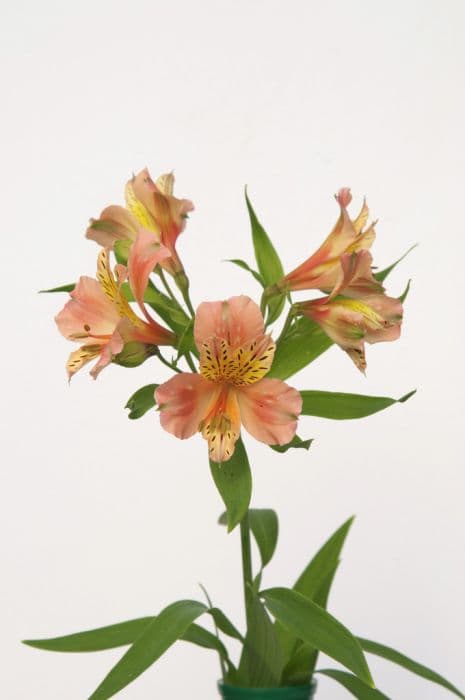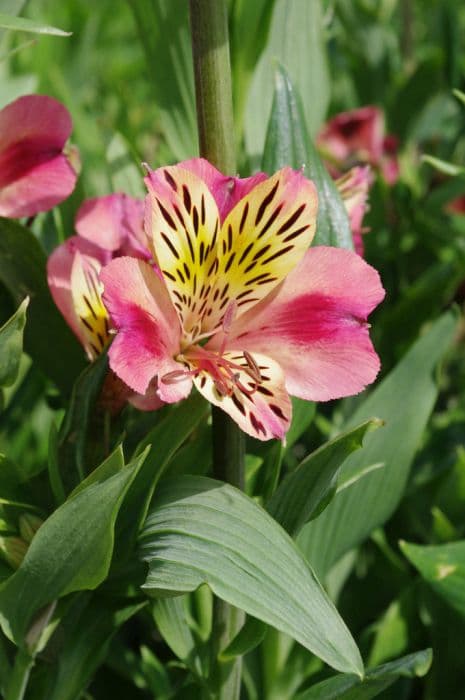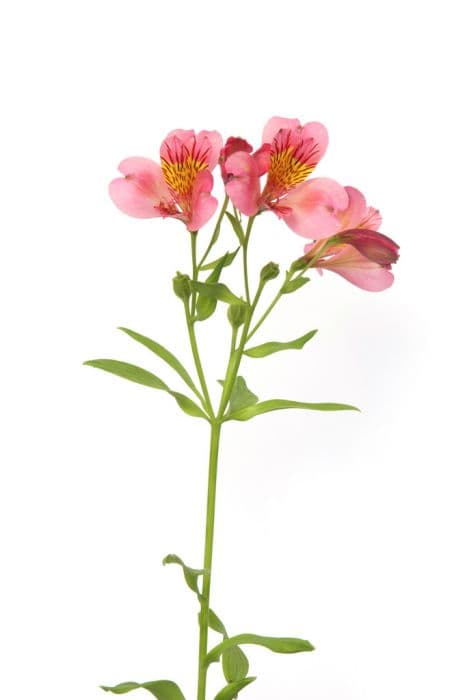Peruvian Lily Alstroemeria Indian Summer = 'Tesronto' (PBR) (Summer Paradise Series)
![Peruvian lily [Indian summer]](/_next/image?url=https%3A%2F%2Fplants-admin.emdemapps.com%2Fimages%2Fplants%2F%2Fimages%2F604b616bc746b.png&w=3840&q=75)
ABOUT
Alstroemeria Indian Summer, also known as the Peruvian Lily, is a striking and vibrant perennial that exhibits a lush appearance characterized by its unique and colorful flowers. The blossoms feature a blend of fiery copper and golden yellow hues, with each petal delicately marked with dark streaks and spots, contributing to its exotic look. It is these signature streaks that give the flowers a richness and depth of color, making them highly attractive and a favorite for cutting gardens and floral arrangements. The foliage of the Peruvian Lily is equally appealing, displaying slender, lance-shaped leaves that provide a contrasting backdrop of deep green and bronze tones. These leaves often have a twisted spiral growth pattern that adds to the overall texture of the plant. Moreover, during the flowering period, the Peruvian Lily produces a generous number of blooms on each stem, creating a dense and vibrant display of color. The plant's overall form is bushy and full, with the leaves and flowers emerging from a clump at the base, giving it a lush and abundant presence in the garden. The Peruvian Lily is celebrated for its resilience and endurance, as well as for the long-lasting nature of its cut flowers, making it ideal for both garden enthusiasts and floral designers seeking a touch of exotic charm in their creations.
About this plant
 Names
NamesFamily
Alstroemeriaceae
Synonyms
Peruvian Lily, Lily Of The Incas
Common names
Alstroemeria 'Tesronto'
 Characteristics
CharacteristicsLife cycle
Perennials
Foliage type
Deciduous
Color of leaves
Green
Flower color
Mixed
Height
2-3 feet (60-90 cm)
Spread
2 feet (60 cm)
Plant type
Herb
Hardiness zones
Varies
Native area
South America
Benefits
 General Benefits
General Benefits- Long flowering period - Alstroemeria Indian Summer has a prolonged blooming time that spans from early summer to late autumn.
- Drought-tolerant - Once established, it can withstand periods of dry weather, making it suitable for water-wise gardens.
- Attracts pollinators - The vibrant flowers are attractive to bees, butterflies, and other pollinating insects, promoting biodiversity.
- Low maintenance - The plant is relatively easy to care for, requiring minimal pruning and upkeep.
- Versatile use - It can be used in borders, containers, and as cut flowers, offering flexibility in its use in gardens and floral arrangements.
- Royal Horticultural Society (RHS) Award of Garden Merit - It has been recognized for its outstanding qualities and performance in the garden.
- Cold hardy - Alstroemeria Indian Summer can tolerate cooler temperatures and is hardy in many climates.
- Colorful foliage - Its bronze foliage adds an additional aesthetic element to the garden, complementing its striking flowers.
 Medical Properties
Medical PropertiesThis plant is not used for medical purposes.
 Air-purifying Qualities
Air-purifying QualitiesThis plant is not specifically known for air purifying qualities.
 Other Uses
Other Uses- Photography Enhancements: Photographers may use the vibrant flowers of Alstroemeria as a natural backdrop to add depth and interest to portrait and macro photography.
- Eco-Friendly Confetti: Petals of the Alstroemeria Indian Summer can be dried and used as biodegradable confetti for weddings or other celebrations.
- Artistic Inspiration: Artists may draw inspiration from the intricate patterns and colors of Alstroemeria Indian Summer flowers for paintings, textile designs, and other creative artworks.
- Dye Production: Some hobbyists use natural plants to create dyes; the petals of the Alstroemeria Indian Summer may offer pigments for fabric or paper dyeing projects.
- Edible Decoration: While not a common practice, the petals of Alstroemeria Indian Summer may be used as edible garnishes for culinary presentation, as long as they are confirmed pesticide-free and safe for consumption.
- Handmade Paper Inclusions: The petals and leaves of Alstroemeria Indian Summer can be incorporated into handmade paper to create decorative and textured craft paper.
- Insect Attraction in Photography: The flower can be used to attract insects in natural photography settings, providing an opportunity for macro photography enthusiasts to capture images of pollinators.
- Cake Decorating: Fresh Alstroemeria Indian Summer blooms can adorn cakes and pastries, especially for botanically themed events, after ensuring they are free from chemicals.
- Plant Companionship: The Alstroemeria Indian Summer can be used in companion planting schemes as a way to bring beneficial pollinators to vegetable gardens and support biodiversity.
- Scrapbooking Embellishments: Pressed flowers and leaves from the Alstroemeria Indian Summer can be used by scrapbookers and crafters to embellish and decorate their projects.
Interesting Facts
 Feng Shui
Feng ShuiThe Peruvian Lily is not used in Feng Shui practice.
 Zodiac Sign Compitability
Zodiac Sign CompitabilityThe Peruvian Lily is not used in astrology practice.
 Plant Symbolism
Plant Symbolism- Friendship: Alstroemeria is often associated with long-lasting friendships due to the strong and enduring nature of the plant, it signifies the enduring nature of relationships.
- Devotion: The multiple blooms from a stem symbolize the multiple ways one can be devoted to another person.
- Wealth: With their lush, full blossoms, they are also a symbol of abundance and prosperity.
- Fortune: The vibrant colors and patterns on the petals represent good luck, making them a popular gift for wishing someone prosperity.
- Achievement: The plant's ability to stand tall and bloom for a long period resonates with the ability to strive and succeed.
 Water
WaterPeruvian lily, commonly known as Alstroemeria, requires regular watering to keep the soil consistently moist but not waterlogged. During active growth in spring and summer, water approximately once a week with about 1 gallon per plant, adjusting for particularly hot or dry weather. Reduce watering in the fall and further in the winter when the plant is dormant. Always check the soil moisture level before watering to ensure it has partly dried since the last watering. Overwatering can lead to root rot, so ensuring good drainage is key.
 Light
LightPeruvian lilies thrive in bright, indirect sunlight. The ideal spot for them is one where they are protected from the harsh afternoon sun, which can scorch their leaves, yet still receive plenty of morning and early afternoon light. An area with dappled sunlight throughout the day is also suitable, especially in a garden setting.
 Temperature
TemperaturePeruvian lilies prefer moderate temperatures and can typically survive in a range that flutters between 40°F at night to around 80°F during the day. They enjoy a cooler climate and do not fare well in extreme heat. The ideal growing temperature for these plants is between 65°F and 75°F during the growing season.
 Pruning
PruningPeruvian lilies require pruning to maintain health and vigor. Deadhead spent flowers to encourage continued blooming and remove any dead or damaged foliage as needed. Prune back the stems in late fall or early winter after the first frost. This helps tidy the plant and encourages new growth in the spring. Be cautious not to over-prune, as this can reduce the number of blooms.
 Cleaning
CleaningAs needed
 Soil
SoilThe Peruvian Lily 'Indian Summer' prefers well-draining soil amended with organic matter, such as compost or well-rotted manure. A soil pH between 6.5 and 7.0 is ideal, ensuring adequate nutrient availability and a supportive environment for root growth.
 Repotting
RepottingPeruvian Lilies should be repotted every 2 to 3 years to refresh the soil and accommodate root growth. For optimal health, repot in the spring before the new growth starts.
 Humidity & Misting
Humidity & MistingPeruvian Lily 'Indian Summer' thrives in moderate humidity, around 40-60%. Too much humidity can promote fungal diseases, while too little can cause stress.
 Suitable locations
Suitable locationsIndoor
Place in bright, indirect light and ensure good air circulation.
Outdoor
Plant in partial sun, shelter from intense heat.
Hardiness zone
7-10 USDA
 Life cycle
Life cycleAlstroemeria, or Peruvian Lily, begins its life cycle when a seed germinates, typically in warm, moist soil conditions. The seedling develops into a young plant with a strong root system and foliage. This perennial herbaceous plant matures and forms clumps with multiple stems bearing lance-shaped leaves. During the flowering stage, which occurs in the summer for the 'Indian Summer' variety, vibrant orange, yellow, and pink blooms appear, usually with distinctive streaks or spots. After pollination, the flowers produce capsules filled with seeds that eventually disperse, completing the reproductive cycle. During the winter or in response to harsh conditions, the plant may become dormant, retreating to its tuberous roots to persevere until the next growing season.
 Propogation
PropogationPropogation time
Spring-Summer
Alstroemeria Indian Summer, commonly known as Peruvian Lily or Lily of the Incas, is usually propagated by division, which is the most popular method. The ideal time for propagation is either in the spring as new growth appears or in the fall after the blooming period has ended. To propagate by division, carefully dig up the clump of rhizomes making sure to keep a good amount of soil around the roots to avoid damage. Separate the rhizomes gently by hand or using a sharp knife, ensuring each division has at least one growth bud. Replant the divisions immediately, spacing them about 12 to 18 inches (approximately 30 to 46 centimeters) apart to give them enough room to grow. Water them well after planting to help establish the roots. This method is preferred as it maintains the characteristics of the parent plant and allows for a relatively quick increase in the number of plants.




![Peruvian lily [H.R.H. Princess Alice]](/_next/image?url=https%3A%2F%2Fplants-admin.emdemapps.com%2Fimages%2Fplants%2F%2Fimages%2F604b55e81c8b0.png&w=640&q=75)
![Peruvian lily [Inticancha Creamy Dark Pink]](/_next/image?url=https%3A%2F%2Fplants-admin.emdemapps.com%2Fimages%2Fplants%2F%2Fimages%2F604b5e98bea7c.png&w=640&q=75)
![Peruvian lily [Inticancha Imala]](/_next/image?url=https%3A%2F%2Fplants-admin.emdemapps.com%2Fimages%2Fplants%2F%2Fimages%2F604b619b522ba.png&w=640&q=75)
![Peruvian lily [Inticancha Red]](/_next/image?url=https%3A%2F%2Fplants-admin.emdemapps.com%2Fimages%2Fplants%2F%2Fimages%2F604b5aebac273.png&w=640&q=75)
![Peruvian lily [Inticancha Sunday]](/_next/image?url=https%3A%2F%2Fplants-admin.emdemapps.com%2Fimages%2Fplants%2F%2Fimages%2F604b646146dd9.png&w=640&q=75)
